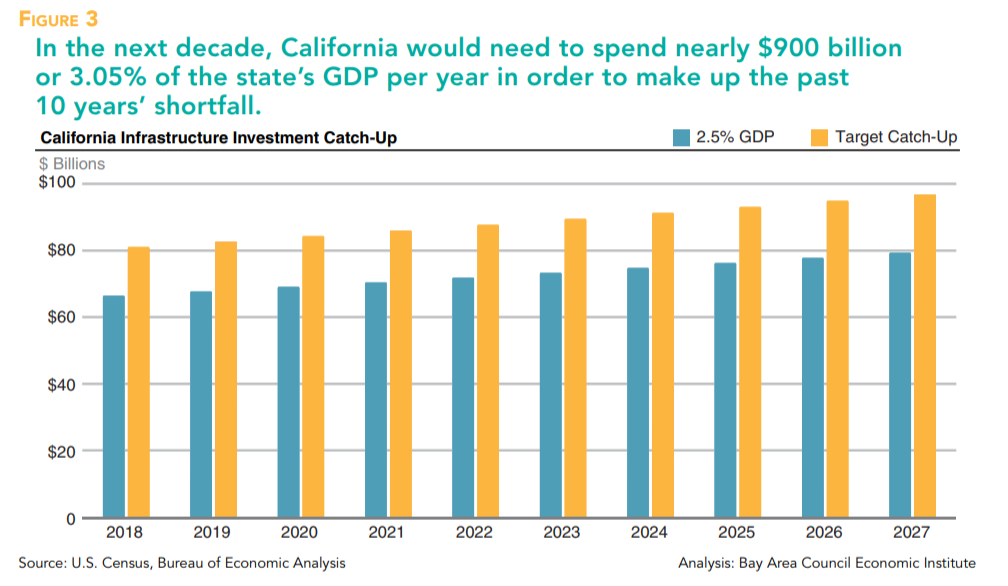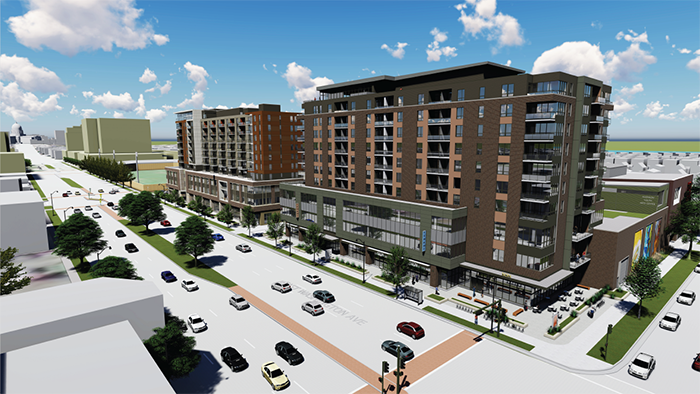 According to a recent article by Calmatters, California has an optimistic and vibrant economic future. Recent data from the U.S. Bureau of Economic Analysis stated that in 2017, the state of California’s GDP rose nearly $2.8 trillion, which makes the California economy now the fifth-largest in the world.
According to a recent article by Calmatters, California has an optimistic and vibrant economic future. Recent data from the U.S. Bureau of Economic Analysis stated that in 2017, the state of California’s GDP rose nearly $2.8 trillion, which makes the California economy now the fifth-largest in the world.
But even as California shows great achievements in overall economic output, it may overshadow the shrinking middle-class job opportunities gap for millions of California residents. Although California has a thriving tech job sector in Silicon Valley, the entertainment capital of Hollywood, and the Central Valley’s agricultural boom, a third of the state’s labor force has mostly low-wage, low-skilled types of jobs. If you visit cities such as San Diego, Santa Cruz or most of the Bay Area, they all come with higher than average cost of living, which includes skyrocketing housing costs. California also has the highest poverty rate in the country: it’s home to 12 percent of the nation’s population, with a disproportionate 22 percent of the nation’s homeless population.
How did California get to this economic place?
From the years spanning 1955 to 1989 California was building 200,000 homes annually, compared to 80,000 per year now, a significant decrease. There is a huge public education issue that has not kept pace with the demand for highly skilled job workers. Not to mention the failing, outdated and inadequately maintained infrastructure. California’s vibrant economy and communities rely on an extensive infrastructure network of highways, bridges, ports, levees, rail lines, public buildings, and energy, water, and wastewater systems. According to The Bay Area Council Economic Institute 2018 report: “California would have to spend almost $900 billion every year for a decade to offset the last 10 years of underinvestment.” But the task of rebuilding social, educational and physical infrastructure will need a multifaceted effort by public and private partnerships and collaboration with state and local governments.
 According to data from the Economic Innovation Group, investors are poised to possibly plugin billions of dollars into the 8,764 “Opportunity Zones” which was included as part of 2017 tax reform law. The TCJA, enactment of sections under tax code Sections 1400Z-1 and 1400Z-2.
According to data from the Economic Innovation Group, investors are poised to possibly plugin billions of dollars into the 8,764 “Opportunity Zones” which was included as part of 2017 tax reform law. The TCJA, enactment of sections under tax code Sections 1400Z-1 and 1400Z-2.
This Federal opportunity zone program was designed and approved by Treasury to zone certain low income urban, suburban and rural area communities as “Qualified Opportunity Zones” where growth has been stagnant. And make these areas eligible to receive “tax-advantaged” private investments. The Federal Reserve’s Survey of Consumer Finances and Financial Accounts of the United States data calculates that there is $6.1 trillion of unrealized capital gains in stocks and funds of US corporations and private investors. Opportunity zones offer one path forward that relies on private capital to bear the cost.
This program is encouraging investors to take their unrealized gains from stocks or other investments and place them into funds that invest in businesses and developments within those designated community zones. The investors then can defer and, depending on how long they hold their investments, reduce their capital gains tax liabilities. Investors and fund managers — venture and angel capital partnerships, private equity firms, investment banks, community development financial institutions, the philanthropic community, and other components of the financial sectors are the ones that are setting up these investment vehicles and creating this new asset class. According to a NYT article “The idea is that investors get federal tax breaks, while the neighborhoods get new businesses and upgraded properties, like apartment buildings, retail shops and hotels.”
California’s Opportunity Zones
Currently, the state of California has 879 Opportunity Zones, (including San Diego) and to get private investment to go in, state and local politicians may have to make some compromises. Which could entail making concessions or balancing rigid land use policies, taxation, and strict environmental protections against access to private capital investment to provide affordable housing development, jobs, infrastructure, and business growth
Time is of the essence, where many potential real estate investors will be looking to invest by the end of the year to get most of the 10-benefit of the investment program.
So while the federal guidance rulemaking process is still being finalized, state and local leaders should be looking to figure out which communities in their districts need new housing, jobs, new business. Public officials should be designing opportunity zone frameworks to support these outcomes.
For example, a framework could be extra tax incentives to offset the usual lower returns from affordable housing investments. According to recent reporting from Lydia Oneil of Bloomberg BNA, the IRS is trying to figure what data can be collected to reveal the impact of the tax breaks, including poverty reduction and job creation vs accelerating gentrification to the benefit of the wealthy.
So taking account the fact that there 3 million people living in California’s opportunity zones, maybe politicians will be able to look past the typical and dynamic transactional view of public-private cooperation on economic development projects. Some are obviously a little skeptical that it will contribute to a more inclusive, and equitable economy for CA.
Civic leaders and investors should look to align local and state incentives with financing tools to focus on the economic needs of the residents in these areas. And no matter how regulations shake out at the federal level, local and state jurisdictions can start by determining priorities, setting standards as well as aligning incentives to encourage these investments.
In the best case scenario, it could generate a pipeline of projects that would be ready to get underway to achieve the projected level of economic output and profit, that could allow both neighborhoods and investors to benefit.
While officials deliberate, investors are diving in: There are already more than 107 funds with $26 billion in total investing capacity as of April 10, according a list gathered by Novogradac & Co. LLP, SF based accounting firm.
According to the website California Opportunity Zone Portal there are projects in need of investment in the areas of affordable housing, community-scale energy and water, transit-oriented development, start-up businesses, workforce and agriculture.
Some of The Featured Project Opportunities include:
Investor benefits -how does it work?
The CPA firm Green Hasson Janks has an article laying out the benefits. Also, this article titled “What is an Opportunity Zone: Tax Benefits & More Explained” goes into more details about tax incentives. If an investor would like to benefit from the qualified opportunity zone program, they must invest in a qualified opportunity fund within 180 days after the sale or like-kind exchange of a capital asset. “Just the gains on an investment — rather than the entire proceeds of a sale — must be reinvested in the opportunity fund.” said Jeffrey Levine, chief executive of BluePrint Wealth Alliance. As an example Say you sold a stock for $500,000, and $300,000 of it was a gain. Just $300,000 must be rolled into the qualified opportunity fund and the remaining $200,000 can be used as the seller wishes.
A QOF is an investment vehicle for investing in eligible property that is located in an OZ and that utilizes the investor’s gains from a prior investment for funding the QOF. The investor can receive stock or an interest in the QOF. The QOF must hold at least 90 percent of its assets in Qualified Opportunity Zone Property (“QOZP”) to remain a QOF.
The specifics can include:
- The program allows a temporary deferral as the capital gain is not taxed before the tax year which includes the earlier of the date on which such investment is sold or Dec. 31, 2026.
- The program also recognizes a tax reduction with a step-up in basis for two different time periods.
- If the investor holds the interest in the fund for at least five years, they receive a basis increase in the investment that equals 10 percent of the deferred gain.
- If the investor holds the interest for an additional 2 years, there is an additional increase in basis of 5 percent.
- Finally, the program provides that if an Investor holds an investment for 10 years, the capital gains accrued on the Fund investment itself – i.e. the fund property’s profit will receive a full step-up in basis for that 10-year period. This final benefit results in a permanent exclusion of taxable income for investments into a Fund.
“Opportunity Zone investments offer compelling tax benefits and a unique incentive for investors to redeploy capital gains while stimulating community revitalization. This program should be a consideration to investors looking to diversify their investments in a variety of asset classes and geographies,” said Michael Fitzpatrick CFO of Baker Tilly Capital, LLC
A Few things to keep in mind when evaluating a potential Opportunity Zone Deal
- What is the up-front, annual and profit-interest fee structure of the QOF?
- Does the QOF have a shovel-ready project to ensure your capital will be invested within the required six months?
- What is the track record of the project developer or business?
- Does the project have strong economic fundamentals?
- Does the QOF plan to have multiple OZ investments, which could complicate the exit strategy and jeopardize the elimination of gains?
- Does the project forecast commensurate risk-adjusted returns?
Conclusion
Policymakers should emphasize the data collection necessary to measure the effects of these programs benefit in improving the lives of low-income people in economically distressed communities. According to Timothy Weaver, an assistant professor of political science at the University at Albany “Money flows into the safe bets, there’s no question, that the primary beneficiaries of the program are the investors.” This is not the first time that tax-favored development zones have been tried before, often with lackluster results. Ultimately, any tax benefit won’t make a bad investment good, but it can make a good investment great. If a fund, PE or other, have the opportunity to invest in an “opportunity zone”, it can provide a significant increase in the returns, whether the investment is held for five or 10 years. RSM US LLP wrote an interesting Q&A article “Opportunity zones: Who profits, when and how?” about this tax subject.


 </
</







